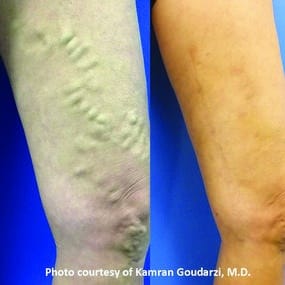For appointments or referrals, please call 651-362-4283 or visit our online appointments page
Providing St. Paul with Chronic Venous Insufficiency Services.
Varicose and spider veins can be painful and make those who suffer feel insecure about showing their legs in public. At Spartz Vein Clinic, we believe everyone deserves freedom from leg pain and the ability to show their legs without embarrassment. We are located in Roseville near the twin cities of Minneapolis and St. Paul, and provide chronic venous insufficiency services along with comprehensive treatment of all types of vein issues.

Varicose Veins
These larger veins often protrude from the skin in bumpy clusters or rope-like designs. These are bigger than reticular veins, and those who suffer often experience aching, burning, heaviness, itching, and night cramps.
Reticular Veins
Reticular veins are bluish colored and appear close to the skin’s surface. These veins do not typically protrude, however they are a little larger than spider veins.
Spider Veins
Spider veins, also known as telangiectasia, are the tiny veins closest to the skin’s surface. While these are often treated for aesthetic reasons, itching and pain can also be a symptom.
Skin Changes
With advanced venous disease, the skin can change in thickness and become discolored. Changes such as these are possibly the result of blood pooling and adding pressure within the leg as blood circulation becomes more difficult.
Swelling
Leg swelling can be a symptom of venous disease. Typically venous swelling gets worse as the day progresses or after standing for extended amounts of time.
Ulcers
Untreated venous disease can cause the break of skin tissue causing venous ulcers. These kinds of ulcers do not heal easily and if the venous disease remains untreated the ulcers often come back.
Deep Vein Thrombosis (DVT)
DVT occurs when a clot forms in a deep vein. These clots are damaging to the vein and can be life-threatening.
Superficial Vein Thrombosis (SVT)
SVT is inflammation of the superficial veins and is somewhat common. With this, a clot forms in a superficial vein and the individual may experience a red tenderness around the vein.